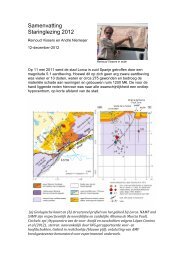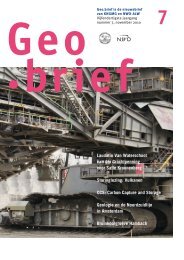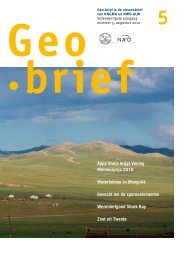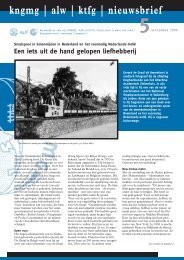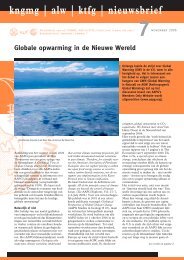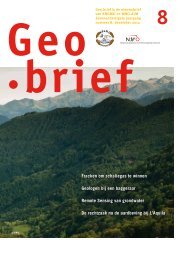You also want an ePaper? Increase the reach of your titles
YUMPU automatically turns print PDFs into web optimized ePapers that Google loves.
Map of the East Indies (printed c. 1700); the official trade zone of the VOC according to the VOC Charter, which was between Cape of Good Hope<br />
(South Africa) and Street Magallan (South America).<br />
amongst other thngs into a growing number<br />
of mining engineers and, from 1910<br />
onwards, also real geologists. Up to that<br />
time the geology was ably handled by the<br />
mining engineers, schooled in Delft, but<br />
the new geological faculties of Leiden,<br />
Utrecht, Amsterdam and Groningen<br />
started to deliver professional geologists.<br />
The top years were from 1920 to 1931<br />
when ‘Mijnwezen’ employed 70-80 mining<br />
engineers and geologists. In the year 1920<br />
a true ‘Geological Survey’ was introduced<br />
in ‘Mijnwezen’ and, independent thereof,<br />
the Technical Highschool of Bandung was<br />
founded. Both developments underlined<br />
the fact that the government had a long<br />
term future of the colony in mind. However,<br />
whereas hundreds of Indonesian students<br />
were sent to Holland for all sorts of<br />
studies, not a single local bright boy was<br />
given a scientific education, in Bandung or<br />
abroad, in geology or mining engineering.<br />
A good part of the time of the employees<br />
of ‘Mijnwezen’ was taken up by semiadministrative<br />
duties following the influx<br />
of private enterprises, searching for all<br />
possible minerals, especially – and by far<br />
most successfully – oil. The pre-war oil<br />
story is one of great success as it can be<br />
safely stated that all the major onshore<br />
oil provinces were detected in the period<br />
1890–1940. The roots of the Royal<br />
Dutch/Shell are in northern Sumatra<br />
where the commercial oil discovery,<br />
Telaga Said, was the first successful<br />
oil venture in the country. Around 1939,<br />
just before the Japanese invasion, the<br />
state employed around 40 geologists.<br />
The transition<br />
The word transition, with the ring of a<br />
friendly, organised handover from one<br />
situation to another, is here a euphemism<br />
for a stack of crises, warfare, frustrations<br />
and illusions.<br />
The Japanese invaders encountered, early<br />
1942, a colonial army (KNIL) that was<br />
soon outflanked, outgunned and outmanoeuvred.<br />
They quickly occupied all<br />
important cities and interned the Dutch<br />
white population. Some of the men were<br />
deported to places like Birma, others<br />
stayed in the concentration camps.<br />
Women and children were locked up<br />
in separate camps. Geologist Van<br />
Bemmelen, head of the Volcanological<br />
Division was first put to work under<br />
moderately good conditions but ended<br />
up like all the others.<br />
After the Japanese capitulation, the<br />
Republik Indonesia was proclaimed and<br />
it was clear that the old ‘order’ would<br />
not return. The much weakened survivors<br />
of the camps largely migrated back to<br />
Holland, but an army of Dutch soldiers<br />
was imported in order to restore ‘order<br />
and justice’. End 1949, after much<br />
bloodshed, the Dutch signed the agreement<br />
that recognised Indonesia as an<br />
independent republic. Relations were still<br />
strained, especially by the New Guinea<br />
question. This island, half Australian and<br />
half Dutch was not included in the 1949<br />
agreement, but the Republik Indonesia<br />
felt strongly that also this part of the<br />
december 2010 Geo.brief 15<br />
Bron: Wikimedia



